On View
John Akomfrah on the Tricky Line Between Art and Cinema
The British filmmaker makes his US debut this month.
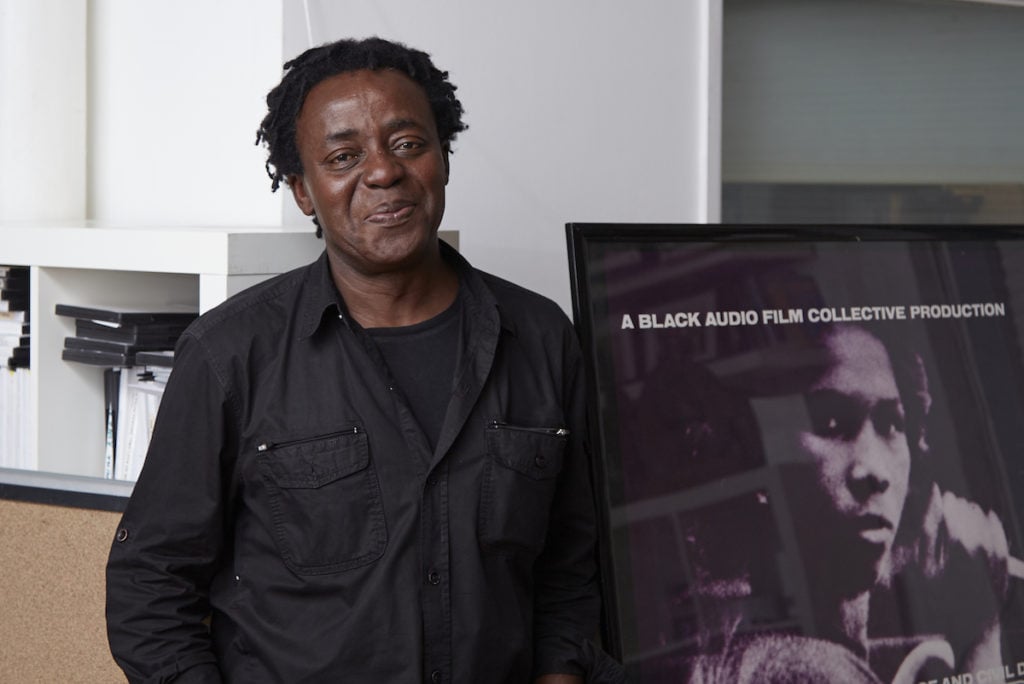
The British filmmaker makes his US debut this month.

After several hours of preparing his first major exhibition in the United States at Lisson Gallery’s Chelsea space John Akomfrah needs a cigarette. And the British artist and filmmaker briefly rushed outside, and flicked the lighter on.
Akomfrah rose to prominence in the 1980s as a founding member of the radical and influential Black Audio Film Collective, and today is known for his multi-channel video works exploring the themes of history, memory, migration, and post colonialism. Utilizing combinations of archival footage and still photography with newly created material to create captivating and enthralling imagery, Akomfrah has found a unique perspective in contemporary time-based art.
At Lisson he presents two new works: The Airport (2016), a three-channel film that explores the significance of empires presented through the architectural ruins, and Auto Da Fé (2016), which examines migration and relocation. The film addresses and critiques a host of contemporary issues while employing the perspective of a 17-century period drama.
After returning from his cigarette, Akomfrah meets me in a private viewing room in the rear of the cavernous gallery to start the interview.
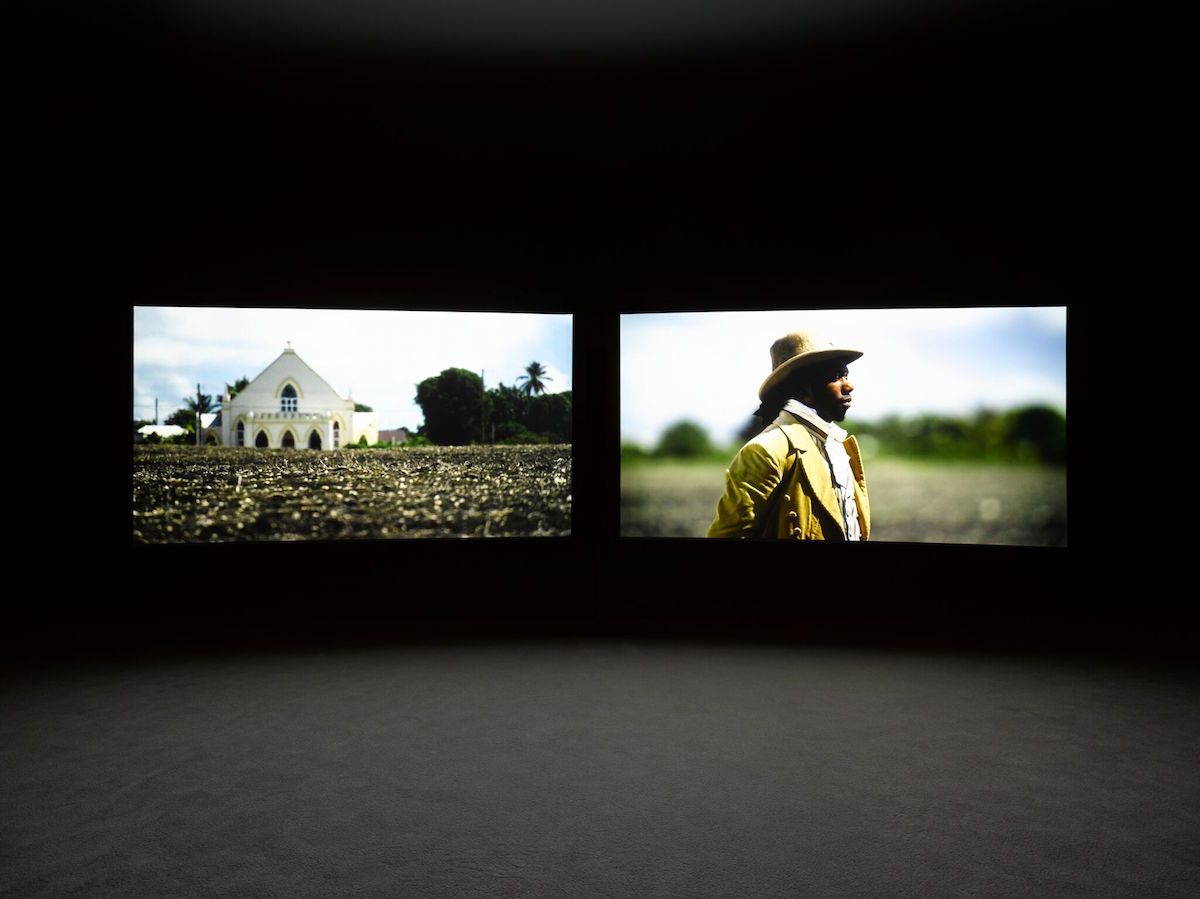
Installation view of John Akomfrah’s Auto Da Fé (2016) at Lisson Gallery, New York. Courtesy Lisson Gallery.
How would you describe yourself? Are you a filmmaker, an artist, both?
I’m certainly a filmmaker, in the sense that I make predominantly time-based work. Recently I think that my time-based work qualifies me to adopt this other category of artist.
Where do you draw the line between art and cinema?
In my case I see cinema not just as movies but as a set of philosophies about the marriage of sound and image. It seems to me that my baggage is now an inheritance, it’s not just a way of working. And if it’s an inheritance one can migrate it to other spaces other than the cinema. So for me the line would be a fairly straightforward one.
Generally cinema one makes for a set of institutions, such as studios and picture houses. They’re very clear institutions, and within those institutions there are certain expectations, markets that need to be hit, success or lack of it with audiences. All of these things are not clichés, they’re necessary in modern cinema. But those institutions don’t contain and control all the implications of cinema, and if they don’t, that means you can take them somewhere else. So it’s not that I don’t believe that there is a line, and that line is defined not so much by my work, but rather the expectations and environments in which one is working. In the art space the regulatory frameworks that define the work are not quite as apparent as they are for me working with the cinema.
One side of it is an interesting philosophical discussion about the limits of the different modes, and I’m not saying that shouldn’t happen, that’s an important conversation to have, but behind that there are other things that are not so abstract, which are very real, like financial agreements, cinema ads, and so on. Those tell you very clearly when you’re in one and when your not. Very, very clearly! (laughs)
What is it about the medium of film that caused you to settle on this format of creation?
The plasticity of film, the possibilities, and its ability to manufacture are all important things for me. Plasticity means that I can commandeer the language and the practices of film to make statements about a whole variety of things in a way that I can’t with other forms. I’m just talking about myself—other people can do the same with just stone or something. For me it’s this plasticity, the way in which you can bend details to fit things.
Because of that philosophy, there’s a century of thinking about how images work that I feel that I’m calling upon. When I’m standing in front of a landscape and a camera, I’m not there on my own, I’m with Godard, Tarkovsky and all manners of filmmakers who’ve done exactly the same thing as me before. So the conversation isn’t just between me and the landscape, it’s also between me and these other guys who are all saying “shoot it like this,” or “shoot it like that,” and you hear these internal voices. That’s what cinema does, and when I say it’s a philosophy that’s what I mean. Those questions, ways of seeing, are important, and that’s just filming. When it comes to editing it is exactly the same. You have all these people saying “cut it quick! That’s the way to go.” Or it could be John Ford saying, “no don’t cut it, just let it breath,” and it could also be Angelopolous or Antonioni or Terrence Manning, a lot of voices, trust me!
It’s like a tradition of shamanic insight and it’s there because you’ve watched it. I’ve seen all of this stuff, I’ve talked to all of these directors, at night, or in my sleep, or awake when I was out for a walk. So we’re now one, and part of this thing. And the difficulty is trying to remove yourself from it, because you’re permanently possessed, contaminated by it—in a good way.
And that’s why for me the distinctions are difficult to make. It’s a little bit like having been brought up by a certain kind family in a town. The fact that I leave to go live elsewhere doesn’t change my past, I can’t get rid of that now. I’m John Akomfrah brought up in London in the ’60s and ’70s by an exiled African family, and I’ve learned other things, but that bit is part of me, that doesn’t go away. Everything else adds to that or chips away a little bit. I’m just an accumulation of things.
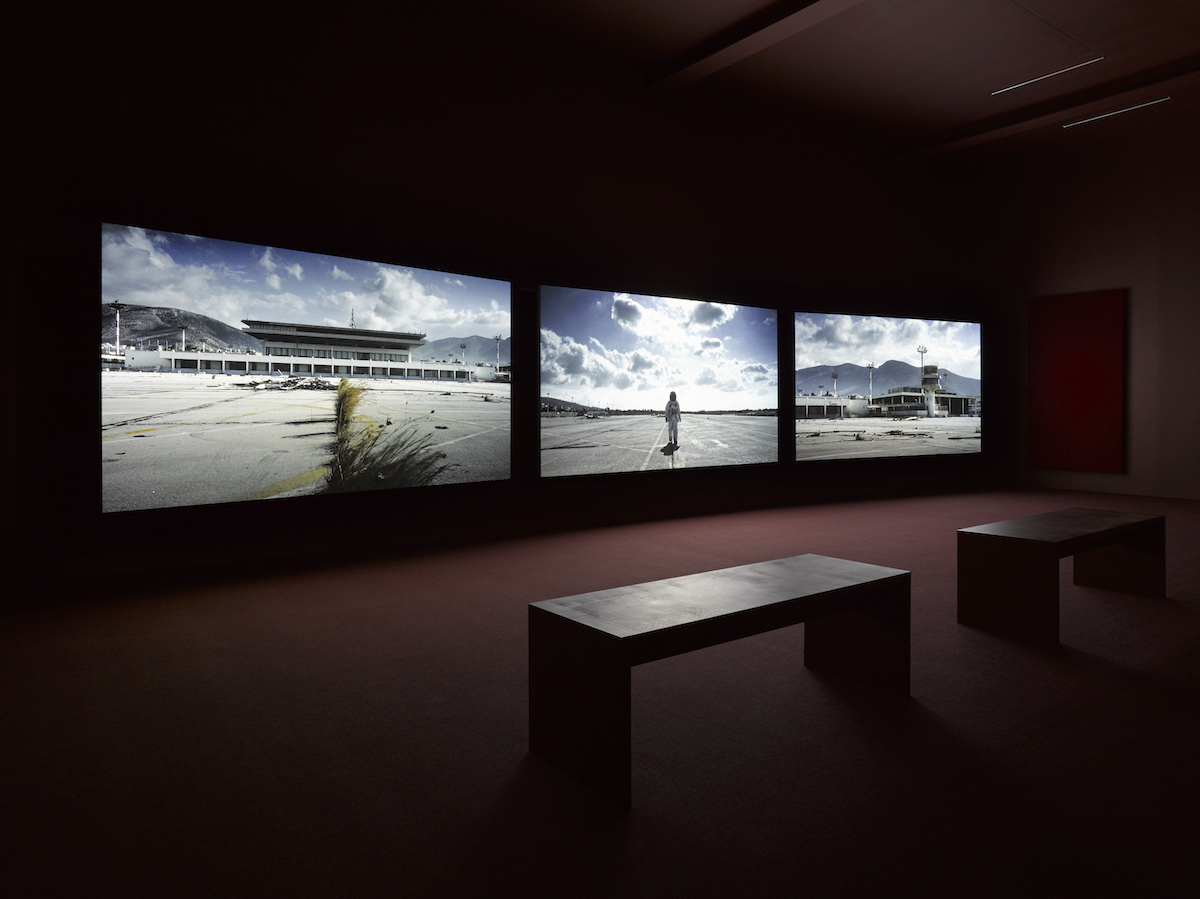
Installation view of John Akomfrah’s The Airport (2016) at Lisson Gallery, New York. Jack Hems © Smoking Dogs Films, Courtesy of Lisson Gallery.
To what extent does politics shape your work?
I don’t set out to make political work. I know that seems weird but its true, but I do set out to make works which are reflections on the political. And I certainly set out do works that interrogate what could be called political narratives.
But the desire is not to make a political work, for me that’s a contradiction. There has to be a work and the work has to have own ontology. Auto Da Fé (2016) is a two-screen piece on refugeeship. That’s what it is and it’s made up of evidence, historical fragments, sonic snatches, dialogue, archival pieces, etc. That’s the work. And that work is not trying to be and is not calling itself a political work. But of course the implications of bringing all of these elements together means that the work resonates politically.
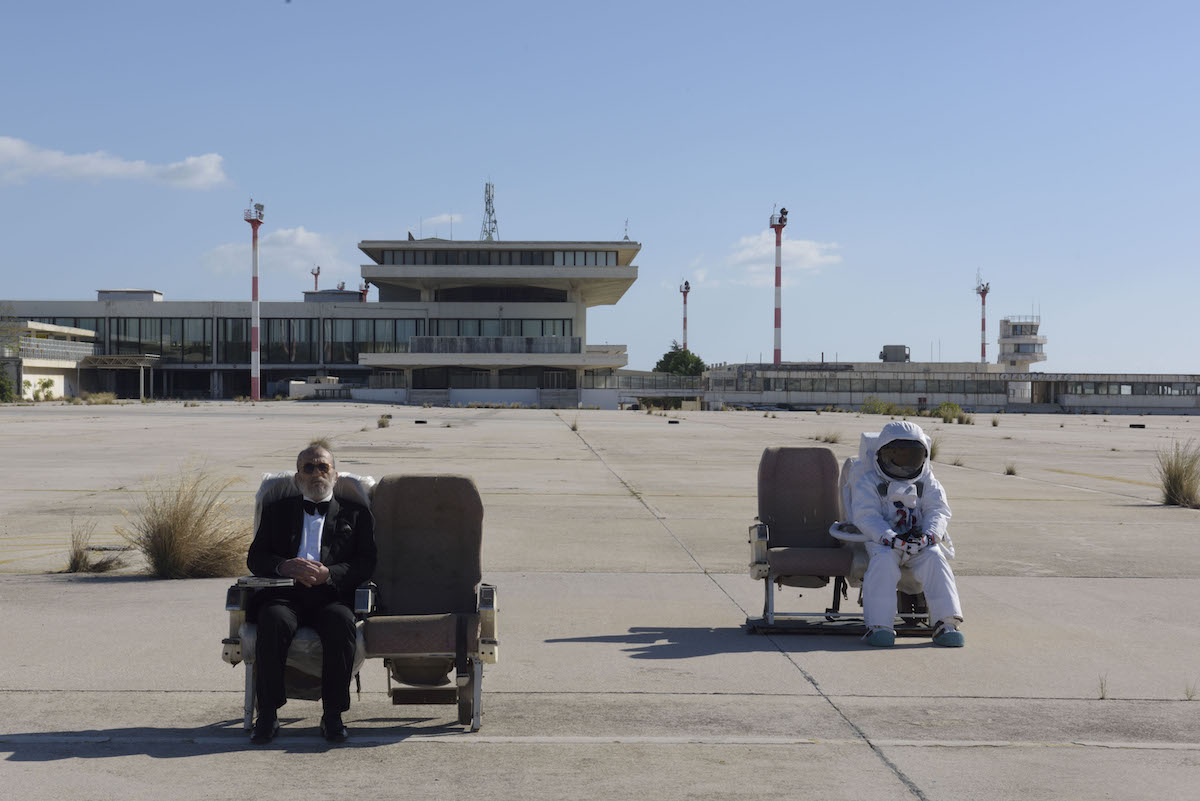
John Akomfrah’s The Airport (2016) at Lisson Gallery, New York. Copyright Smoking Dog Films, Courtesy of Lisson Gallery.
Will you take me through your role within the Black Audio Film Collective?
In Black Audio I was one of eight. We were roughly the same age, but I was one of the elder ones. When you’re 17 or 18, one or two years is a major thing, by implication that meant that I had more of a say and a voice.
It was a collective in the sense that it worked on the assumption that there were eight people all of whom had different kinds of expertise, different ways of doing things. So some were great with taking photographs, others were great with working with found footage, some were fantastic at making sonic pieces and the desire was to bring that all together.
We were part of that great wave, that bulk of of second generation of postwar migrants born in England sometime between 1958-59 and 1968-69. We didn’t have an elsewhere except that place, and that was very much a bond. The bond was both to take this as a blessing, and a responsibility, and a gift. You have insights into a place by virtue of this that other people don’t. So since that’s the case what the hell can you do with it? What can you say both to yourselves and to the broader culture, about itself and you?
And so race, yes, was important in that sense. You’ve got to remember as well that narratives are weird things because narratives come into being because they reach a certain kind of critical mass. “Black people, are not good people because the are all immigrants and thieves,” or whatever. I think we were aware of that very quickly. We were aware that counter-narratives were very important. I may come from a migrant family, but I’m not an immigrant. Little things like that were important as a way of getting a kind of cultural autonomy or legitimacy for certain identities.
The sort of insights that people take for granted about England, “Oh, it’s multicultural”, “Oh, it’s so different from the rest of the world.” Well, it’s different because lots of different people fought for it. Different doesn’t just happen. And it’s in that sense that race is important. It was important as an insight, as a burden, as a responsibility, and we took all of those on board. We really liked certain things for ourselves, and that was pretty much Black Audio, and it’s not that I think all of that is in the past because the group finished, but four of the eight are still working together, we found a way of working that suited us.
Your new work deals extensively with history. What’s behind your preoccupation with the past?
I’m very interested in the notion of ghosting, of having phantoms and how cultures are populated by unseen guests. It has to do with the question of what one might call a racial identity. When I was much younger in the ’70s in England; you were aware that you led this life with a doppelgänger. There was this figure who looked like you and that behaved not quite like you, but you were aware that when other people spoke about that figure, they were trying to speak about you.
That’s the language of race—coming to the realization that this fiction of separation that you thought you had is because you had already been ventriloquized by this already existing thing, this phantom called “the black person as trouble.” And slowly you start to work out how it is that you might make work that interrogates these factors. By opening certain doors, “Aaah, there they are, that’s where you are.”
Especially in the ’70s and ’80s when you met somebody else, usually a figure of authority—let’s say you met a policeman on the street—you were aware that standing around you, behind you, were all kinds of other guests; the kid he arrested the day before behaved in a certain way, what he thinks your propensities are. And you are the same. You heard that policemen are usually inclined to frame you.
They’re the ghosts of past embodiments of you. The interest in the historical is partly just an attempt to slide away the burden of history, by just understanding it’s presence one could liberate oneself from it.
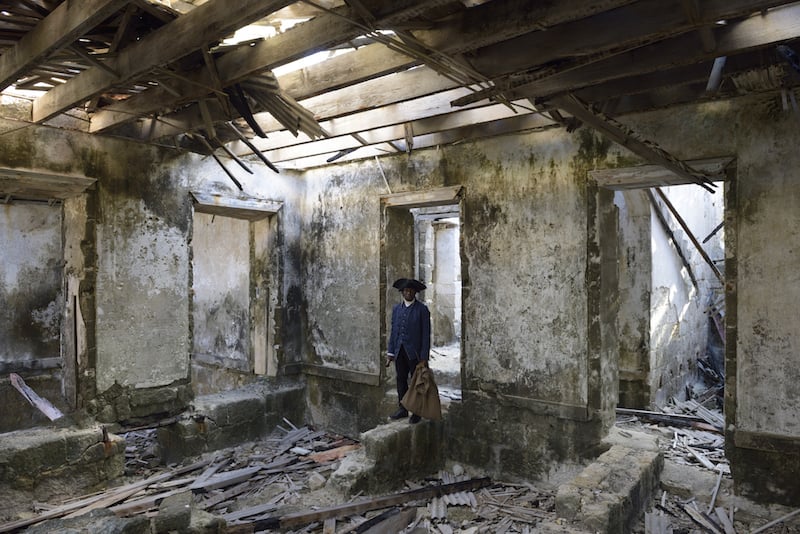
John Akomfrah’s Auto Da Fé (2016). Photo: Courtesy Lisson Gallery.
Your new work addresses the themes of migration and movement of people. Is this your response to the current migration crisis in Europe?
It is only in the sense that it forced me to deal with all kinds of other things. Auto Da Fé (2016), for instance, I made specifically because I started to think through what the current crisis means now. There’s a timeline that goes back to the dawn of our modernity, look at the narrative. In 1492 Queen Isabella says to Vasco da Gama, “You have my blessing go and see the world,” but at the same time that she’s telling the Sephardic Jews, “Leave this land because you don’t belong here.”
The two things are separate motions almost at the same time. Part of the rhythm of modernity is this endless churning over of people having to flee, or take flight because they are deemed to be surplus to requirements, or deemed to be unfit to be in a place. We’ve been with this mantra for half a millennia. A very long time.
So I was keen to try and do something on the current crisis but not to take its currentness too seriously. Somebody always says “Oh, yes, well the Sephardic Jews fleeing Brazil to go to the Caribbean, that was new.” Well no, it’s not new, because the same community fled Portugal to go to Brazil, and then for the same reasons they left Brazil to go to the Caribbean and then probably for similar reasons left the Caribbean to go to the United States.
But this is not an isolated incident, the same dialogue is taking place now. If you take the displacement of Sephardic Jews, it’s five centuries old, it is not new. To endlessly be telling people “Oh, this is unusual,” is flawed. It’s not unusual at all, actually, it’s the default of our modernity. There have to be narratives of flight because these narrative co-exist with narratives of settlement, and have a profound dialogue with each other. That’s what I’m interested in and am trying to excavate.